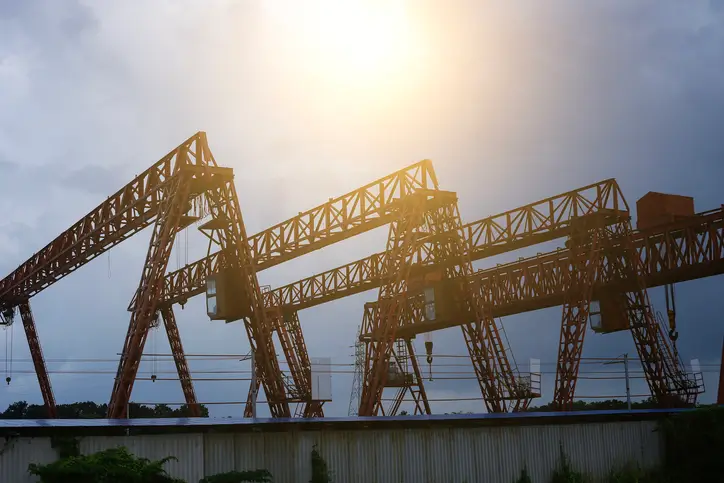Overhead & Gantry Crane Safety: A Complete Guide
Overhead and gantry cranes play a vital role in industrial and construction settings, allowing workers to move heavy loads with ease and efficiency. However, the use of these cranes introduces specific hazards that, if not properly managed, can lead to serious accidents, injuries, and even fatalities. Understanding the common hazards associated with overhead and gantry cranes is essential for both employers and employees to ensure a safe work environment. This guide explores these hazards, backed by statistics and expert insights, and provides safety measures to minimize risks.
1. Common Hazards Associated with Overhead and Gantry Cranes
Overhead and gantry cranes are large, powerful machines that are often operated in busy environments with significant foot traffic and other machinery. Here are some of the most common hazards linked to their operation:
1. Load Dropping or Slipping
One of the primary dangers in crane operations is the risk of load dropping or slipping. Loads that are not properly secured can fall, posing a severe risk to workers below. Common reasons for load dropping include improper rigging techniques, using the wrong lifting equipment, and inadequate load inspections. According to safety reports, incidents involving dropped loads can be catastrophic and often lead to fatalities.
2. Crane Collisions
Overhead and gantry cranes operate along a fixed path, but they may still collide with other machinery, structures, or even other cranes if not correctly positioned or monitored. Collisions often occur due to poor communication, lack of situational awareness, and inadequate signaling systems. The impact of these collisions can cause structural damage and pose risks to workers and equipment.
3. Electrical Hazards
Cranes near power lines pose electrical hazards, risking electric shock, burns, or electrocution. Maintaining safe distances and operator awareness is crucial.
4. Poor Maintenance Leading to Mechanical Failures
Regular crane maintenance prevents equipment malfunctions, like worn hoist chains or frayed ropes, which can cause load drops and breakdowns.
5. Operator Error
Operating a crane requires skill, precision, and a clear understanding of its functions. When operators are untrained or unfamiliar with specific crane models, the likelihood of human error increases. These mistakes can include overloading the crane, improper positioning, and miscommunication with rigging personnel. According to the Occupational Safety and Health Administration (OSHA), most crane-related accidents can be attributed to operator error.
6. Inadequate Visibility and Blind Spots
Large cranes often have blind spots that make it difficult for operators to see surrounding areas clearly. Poor visibility can result in accidental collisions, dropped loads, and risks to workers who are out of the operator’s line of sight. Insufficient lighting, weather conditions, and the sheer size of the crane can further exacerbate visibility issues.
2. Industries Most Susceptible to Overhead and Gantry Crane Hazards
Overhead and gantry cranes are common in industries that require heavy lifting, positioning, and precise load placement. Here are some industries where crane hazards are most prevalent:
1. Construction
In construction, overhead cranes are often used to lift building materials to heights, and gantry cranes assist in loading and unloading materials on-site. Given the active and dynamic nature of construction sites, crane hazards such as dropped loads, collisions, and electrical hazards are a constant concern.
2. Manufacturing
In manufacturing plants, cranes are frequently used to move large machinery and heavy materials across the facility. Given the proximity of machinery and workers, manufacturing facilities face risks of collisions and load drops. Properly training workers and conducting regular crane maintenance are essential in these environments.
3. Warehousing and Logistics
Warehouses and logistics centers use cranes to load and unload heavy items from trucks or transfer goods within the facility. Since these cranes are often operated in enclosed spaces, there is a high risk of collisions with structures and other machinery. Cranes in these environments need to be operated with precision and situational awareness to avoid accidents.
4. Shipping Ports
Shipping ports rely heavily on overhead and gantry cranes to unload and load cargo from ships. Given the vast number of containers and the high pace of operations, crane hazards such as load drops, collisions, and poor visibility are common. Safety protocols and continuous monitoring are necessary to prevent accidents in these settings.
3. Preventive Measures for Overhead and Gantry Crane Hazards
While crane-related hazards are prevalent in several industries, effective preventive measures can significantly reduce risks and ensure a safer work environment. Here are some best practices to minimize these hazards:
1. Regular Equipment Inspections and Maintenance
Routine inspections and maintenance are crucial for crane safety. OSHA recommends pre-shift inspections to identify any mechanical or structural issues that could compromise crane operation. Regularly inspecting hoist chains, ropes, hooks, and electrical systems can prevent malfunctions that may lead to accidents.
2. Proper Training and Certification for Operators
Crane operators should be trained and certified to handle specific crane models. Training programs help operators understand the limitations of each crane, the safe operating procedures, and how to respond to emergencies. Certified operators are better equipped to handle crane controls and mitigate risks associated with human error.
3. Implementing Load-Lifting Protocols
Ensuring that loads are adequately secured and balanced before lifting can prevent load drops. Proper rigging techniques, weight checks, and load assessments are essential to avoid accidents. Additionally, using appropriate equipment such as slings, hooks, and load cells tailored to specific loads can improve safety.
4. Creating a Communication System
Effective communication between crane operators and ground personnel can prevent collisions and missteps. This may include the use of hand signals, radios, or a designated signal person who assists the operator in guiding the crane’s movements. Clear communication minimizes the chance of errors and ensures coordinated movement.
5. Establishing Safe Work Zones
Designating specific zones for crane operations and limiting access to authorized personnel can reduce the risk of injuries. Barricades, safety cones, and warning signs around the crane’s operating area help keep workers and bystanders at a safe distance. This practice is especially crucial in busy industrial or construction sites.
6. Maintaining Safe Distances from Power Lines
To mitigate electrical hazards, OSHA recommends maintaining a minimum distance of 10 feet from power lines for cranes operating in their vicinity. When it’s necessary to work closer, de-energizing and grounding the power lines can prevent accidental contact.
Conclusion
Overhead and gantry cranes are vital in heavy industries but come with significant risks, including dropped loads, mechanical failures, electrical hazards, and collisions. To mitigate these risks, industries should enforce regular maintenance, provide thorough operator training, and establish robust communication protocols. Prioritizing crane safety ensures compliance, protects workers, and preserves equipment integrity.







